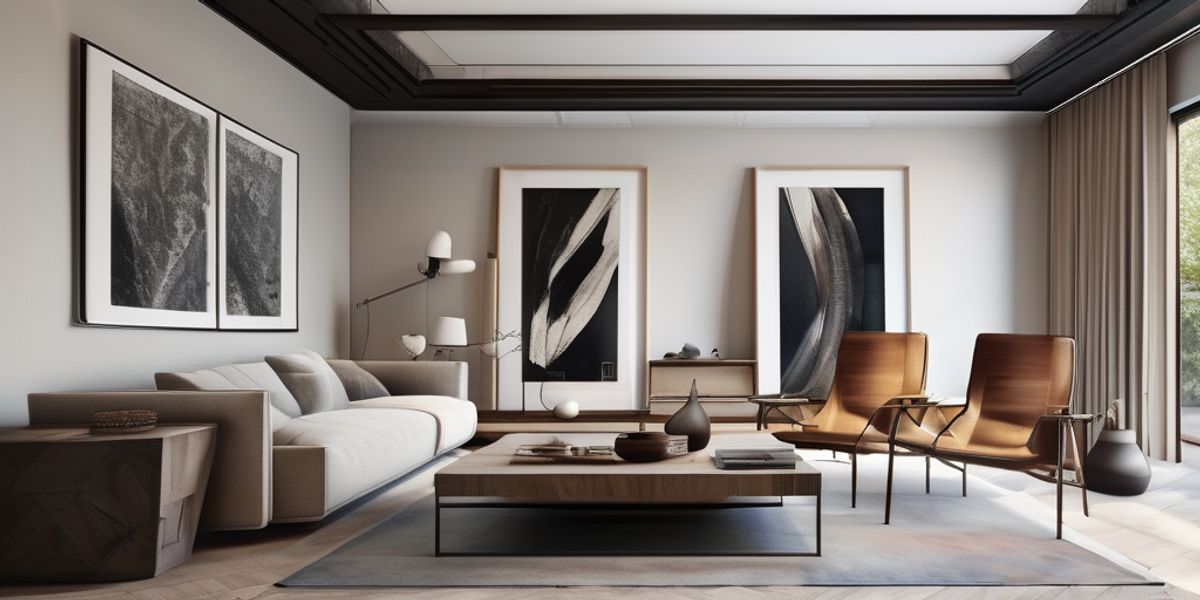Still life art, a genre traditionally associated with the depiction of inanimate subjects, has found a unique place in modern home design. This article explores how the timeless allure of still life can be seamlessly integrated into contemporary living spaces, enhancing aesthetics and ambiance. By selecting the right pieces and strategically placing them, still life art can transform an ordinary room into a visually captivating and emotionally resonant space.
Key Takeaways
- Understand the historical and aesthetic significance of still life art to appreciate its role in modern design.
- Consider color, composition, and theme when choosing still life pieces for your home.
- Use strategic placement to make still life art a focal point in various spaces.
- Incorporate complementary decor elements to enhance the impact of still life artworks.
- Employ effective lighting techniques to highlight the beauty of still life art in your home.
The Essence of Still Life Art in Contemporary Spaces
Defining Still Life Art
Still life art, traditionally known for its depiction of inanimate subjects, has evolved to become a vital component in modern interior design. It offers a unique way to bring a piece of timeless beauty into contemporary spaces, blending the old with the new seamlessly.
How Still Life Influences Modern Aesthetics
The incorporation of still life art in modern aesthetics is not just about adding visual elements; it’s about creating a dialogue between the art and the space. Still life artworks serve as a focal point, enriching the environment and adding layers of depth and meaning.
Blending Traditional Art with Contemporary Design
Integrating traditional still life art into contemporary design involves a careful balance of elements. This can be achieved through thoughtful placement, choice of framing, and coordination with other decor elements. The result is a harmonious blend that enhances both the art and the space around it.
Choosing the Right Still Life Pieces
Factors to Consider When Selecting Art
When choosing still life art for your home, consider the overall theme of your space, the dimensions of the art, and how it complements your existing decor. The emotional impact of the artwork is crucial as it sets the tone for the room. Additionally, think about the artist’s reputation and the artwork’s potential investment value.
The Role of Color and Composition
Color and composition are pivotal in how a piece of art integrates with your room’s aesthetic. A harmonious blend can enhance the mood and visual appeal of a space. For instance, a vibrant, colorful still life can add energy to a room, while a more subdued palette can create a calming atmosphere.
Balancing Themes and Styles
It’s important to balance the themes and styles of your art pieces to avoid a cluttered or disjointed appearance. Aim for a mix that reflects a cohesive story or theme. Consider using a table to organize your thoughts on potential art pieces:
| Art Piece | Theme | Style |
|---|---|---|
| Floral Composition | Nature | Realistic |
| Abstract Forms | Modern | Abstract |
This structured approach helps in visualizing how different pieces might complement each other in your space.
Strategic Placement of Still Life Artworks
Focal Points in Living Areas
Creating a focal point with still life art in living areas not only enhances the aesthetic appeal but also draws the viewer’s attention. Consider placing a significant piece above the fireplace or on a prominent console table to maximize impact. This strategic placement can spark conversation and set the desired mood in the space.
Enhancing Small Spaces
In smaller spaces, the right artwork can make a room feel larger and more inviting. Use lighter colored frames and smaller scale pieces to avoid overwhelming the area. Placing art in unexpected places, like a narrow hallway or a tiny nook, can add character and depth to these areas.
Creating Visual Flow with Art Placement
To create a seamless visual flow, align your artworks with the natural lines and movement of your room. Position pieces at eye level and consider their relationship to other decor elements. A well-planned art placement can guide the viewer through the room, making each space feel connected and purposefully designed.
Integrating Art with Home Decor Elements
Matching Art with Furniture
Selecting the right art to complement your furniture can transform a room from ordinary to extraordinary. Consider the style and era of your furniture when choosing art. For example, a modern abstract painting pairs well with minimalist furniture, while a classic still life might suit a more traditional setting. Ensure the art and furniture do not clash, but rather enhance each other.
Using Art to Set the Mood of a Room
Art has the power to influence the mood and atmosphere of a space. Choose pieces that reflect the desired ambiance of the room. For a calming effect, opt for artworks with soft colors and gentle forms. For a more vibrant setting, choose bold and dynamic pieces. This strategic choice can make all the difference in creating the right vibe.
Complementary Decor and Art
When integrating art into your home decor, it’s crucial to consider how various elements complement each other. Use a mix of textures and materials in both your art and decor to create a cohesive look. Here are some tips to achieve harmony:
- Pair textured artworks with smooth, clean-lined decor.
- Match color tones between your art and decorative items.
- Use lighting to highlight both art and decor elements effectively.
Lighting Techniques for Showcasing Art
Natural vs. Artificial Lighting
Choosing the right lighting for art can dramatically affect its appearance and the ambiance of a room. Natural light is ideal for displaying art as it closely resembles how art is viewed in galleries. However, the variability of natural light can sometimes be a disadvantage. Artificial lighting, on the other hand, offers consistency and can be controlled to highlight specific features of the artwork.
Highlighting Artwork with Light
Effective lighting can transform an artwork from looking flat to having depth and vibrancy. Use directional lights such as spotlights or track lights to highlight architectural details and draw attention to specific elements of the artwork. This technique not only enhances the art but also adds a dramatic touch to the space.
Lighting Tips for Art Display
When lighting artwork, consider the following tips:
- Use adjustable lighting to change the mood and focus as needed.
- Avoid direct sunlight which can cause fading and damage.
- Balance the intensity and color of the lights to avoid overpowering the artwork.
Proper lighting is essential not only for enhancing the visual appeal of the artwork but also for preserving its colors and details over time.
The Impact of Still Life on Room Ambiance
Art and Emotional Influence
Still life art is not just visually appealing; it also plays a crucial role in influencing the emotions of a room. The choice of subjects, colors, and composition can evoke a range of feelings, from calmness to excitement, making it a powerful tool in interior design.
Transforming Spaces with Art
Art has the power to transform any space by adding layers of meaning and interest. Strategic placement can turn a mundane room into a captivating environment, enhancing the overall aesthetic and functional value.
Art as a Tool for Room Transformation
Incorporating still life art effectively requires understanding its impact on space perception and ambiance. Art pieces can serve as focal points or harmonize with other elements to create a cohesive look. This strategic use of art not only beautifies the space but also optimizes its utility.
Maintaining and Preserving Still Life Art
Regular Care Tips
Proper maintenance is crucial for the longevity of still life artworks. Regular dusting and avoiding direct sunlight are basic steps to keep the colors vibrant and the material intact. Ensure that the humidity and temperature of the room are controlled to prevent any damage to the canvas or paint.
Protecting Art from Environmental Damage
Environmental factors like sunlight, humidity, and pollution can severely affect art pieces. Utilize UV protective glass for framing and place artworks away from areas with high exposure to these elements. This proactive approach helps in preserving the quality and value of the art.
Long-term Preservation Strategies
For those looking to keep their still life artworks in prime condition for generations, consider consulting with art conservationists. They specialize in techniques that not only restore but also preserve artworks. Regular professional cleaning and the use of archival materials for storage are recommended to ensure the art remains pristine over time.
Exploring the Trends in Still Life Art
Popular Themes in Contemporary Art
Contemporary still life art is seeing a resurgence of traditional themes with modern twists. Floral motifs, everyday objects, and abstract forms are increasingly popular, reflecting a blend of nostalgia and innovation. Artists are experimenting with scale and context to give these classic subjects a fresh perspective.
Emerging Artists to Watch
The art world is buzzing with talented newcomers who bring unique visions to still life. Highlighted artists include Elena Briggs, known for her vibrant use of color, and Tomás Reynoso, who incorporates digital elements into his paintings. These artists are setting the pace for the future of still life art.
How Trends Influence Art Choices
Art collectors and enthusiasts are guided by current trends when selecting pieces for their spaces. The popularity of minimalist designs and bold, large-scale works influences purchasing decisions, making a significant impact on the aesthetics of modern interiors.
Conclusion
Incorporating still life art into modern home design not only enhances the aesthetic appeal of a space but also imbues it with a sense of history and personal expression. As we’ve explored, the versatility of still life art allows it to seamlessly integrate into various design styles, from minimalist to eclectic. By selecting pieces that resonate with personal tastes and complement the existing decor, homeowners can create a unique and inviting atmosphere. Whether through strategic placement, thematic consistency, or creative juxtaposition, still life art remains a timeless and impactful element in home design.
Frequently Asked Questions
What is still life art?
Still life art is a genre of painting and drawing that focuses on arranging objects such as flowers, fruits, and everyday items in a composition, often to convey a specific theme or message.
How can still life art enhance modern home design?
Still life art can add a touch of elegance and personal expression to modern home design, offering visual interest and helping to tie together different elements of a room’s decor.
What should I consider when choosing still life art for my home?
Consider the color scheme, size, and style of the artwork to ensure it complements your existing decor. Also, think about the mood you want to set in the room and choose art that reflects that.
Where is the best place to display still life art in a home?
Still life art can be displayed prominently as a focal point in living areas, or used to enhance smaller spaces with its detailed and often intricate compositions.
How can lighting affect the display of still life art?
Proper lighting is crucial in showcasing still life art effectively. Natural light can highlight the colors and details of the artwork, while artificial lighting can be used to create dramatic effects and enhance the mood of the room.
How do I maintain and preserve still life art?
Regular dusting and avoiding direct sunlight are basic steps to maintain still life art. Additionally, consider using frames with UV-protective glass and maintaining a stable environment with controlled humidity and temperature.

